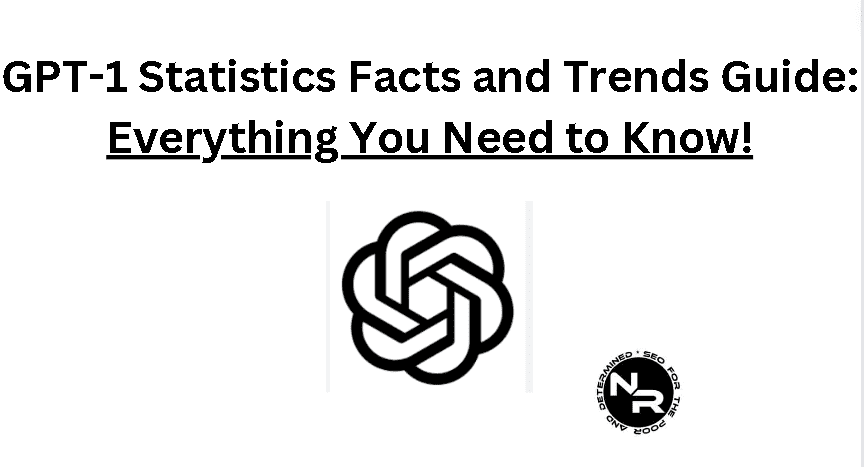Disclosure: Some of the links you’ll encounter are affiliate links. If you click and buy something, I’ll get a commission. If you’re reading a review of some precious metals company, please understand that some of the links are affiliate links that help me pay my bills and write about what I love with no extra cost to you. Thank you!
Looking for the latest GPT-1 statistics facts and trends for 2024?
My updated guide has everything you need to know, and more.
All the references and resources I used in crafting my GPT-1 stats guide are listed at the bottom of the page.

Table of Contents
Key GPT-1 Statistics Facts and Trends
- GPT-1 was released in 2018 by OpenAI as their first iteration of a language model using the Transformer architecture.
- The architecture that supported GPT-1 while it was live is 12-level, 12-headed Transformer decoder (no encoder), followed by linear-softmax.
- While it was live GPT-1 had 120 million parameters. This pales in comparison to GPT-2 which had 1.5 billion parameters and GPT-3 which had 175 billion parameters.
- GPT-1 was trained on BookCorpus, which is a 4.5 GB of text compromising of 7000 unpublished books of various genres. OpenAI picked BookCorpus as a perfect training dataset because the long passages of continuous text in the unpublished volumes of fiction helped GPT-1 handle better long-range information.
- GPT-1 was not trained using RLHF technique.
- CommonCrawl was not used to train GPT-1.
- The cost of training GPT-1 is currently unknown and undisclosed by OpenAI.
What Is GPT-1?
GPT-1 (Generative Pre-trained Transformer 2) was a large language model built by OpenAI (learn about OpenAI in my OpenAI statistics post) and the first in their foundational series of GPT models (GPT-1, GPT-2, GPT-3, ChatGPT built on GPT-3.5 and GPT-4).
When Did OpenAI Launch GPT-1?
GPT-1 was released in 2018 by OpenAI as their first iteration of a language model using the Transformer architecture.
What Architecture Supported GPT-1 While the Model Was Live?
The architecture that supported GPT-1 while it was live is 12-level, 12-headed Transformer decoder (no encoder), followed by linear-softmax.
How Many Parameters Did GPT-1 Have While It Was Live?
While it was live GPT-1 had 120 million parameters. This pales in comparison to GPT-2 which had 1.5 billion parameters and GPT-3 which had 175 billion parameters.
Learn about GPT-2 and GPT-3 by reading my GPT-2 statistics and GPT-3 statistics guides next.
OpenAI keeps a secret the number of parameters of GPT-4, but estimates vary between 200 billion to 220 billion parameters.
Learn about GPT-4 by reading my GPT-4 statistics guide next.
What Data Was GPT-1 Trained on?
GPT-1 was trained on BookCorpus, which is a 4.5 GB of text compromising of 7000 unpublished books of various genres.
OpenAI picked BookCorpus as a perfect training dataset because the long passages of continuous text in the unpublished volumes of fiction helped GPT-1 handle better long-range information.
Other datasets were considered but ultimately rejected due to long strings of polluted text (gibberish sentences).
| architecture | parameter count | training data |
|
|---|---|---|---|
| GPT-3 | GPT-2, but with modification to allow larger scaling. | 175 billion | 570 GB plaintext, 0.4 trillion tokens. Mostly CommonCrawl, WebText, English Wikipedia, and two books corpora (Books1 and Books2). |
| GPT-2 | GPT-1, but with modified normalization | 1.5 billion | WebText: 40 GB of text, 8 million documents, from 45 million webpages upvoted on Reddit. |
| GPT-1 | 12-level, 12-headed Transformer decoder (no encoder), followed by linear-softmax. | 0.12 billion | BookCorpus: 4.5 GB of text, from 7000 unpublished books of various genres. |
Was GPT-1 Trained Using the RLHF Technique?
GPT-1 was not trained using RLHF technique. RLHF (Reinforcement Learning from Human Feedback) was used to train GPT-3, ChatGPT and GPT-4 language models.
Who Can use GPT-1?
Currently, no one can use GPT-1 given that OpenAI retired that model a long time ago.
Was CommonCrawl Used to Train GPT-1?
CommonCrawl was not used to train GPT-1.
CommonCrawl was used to train GPT-3, ChatGPT and GPT-4.
Was GPT 1 Able To Generate AI Images Similar to DALL-E?
GPT-1 was a primitive LLM barely able to string a few coherent sentences together. It was not able to generate AI imagery similar to what OpenAI DALL-E can do.
Learn about the DALL-E AI image generator by reading my DALL-E stats post next.
Are There Any AI Writing Tools Using GPT-1?
Currently, there are no AI writing tools using GPT-1. It’s an obsolete language model whose purpose was more to showcase the bright future ahead than to generate any meaningful volume of textual content.
GPT-1 Stats Facts and Trends Guide (Conclusion)
My updated guide lists the best and latest GPT-1 statistics facts and trends for 2024.
I hope you enjoyed it because the guide is now over.
During my research, I consulted these resources below:
References:
- (https://en.wikipedia.org/wiki/GPT-1)
- (https://www.makeuseof.com/gpt-models-explained-and-compared/)
- GPT-1, GPT-2 and GPT-3 models explained
(https://360digitmg.com/blog/types-of-gpt-in-artificial-intelligence) - The Journey of Open AI GPT models
(https://medium.com/walmartglobaltech/the-journey-of-open-ai-gpt-models-32d95b7b7fb2)
Nikola Roza
Nikola Roza is a blogger behind Nikola Roza- SEO for the Poor and Determined. He writes for bloggers who don't have huge marketing budget but still want to succeed. Nikola is passionate about precious metals IRAs and how to invest in gold and silver for a safer financial future. Learn about Nikola here.
